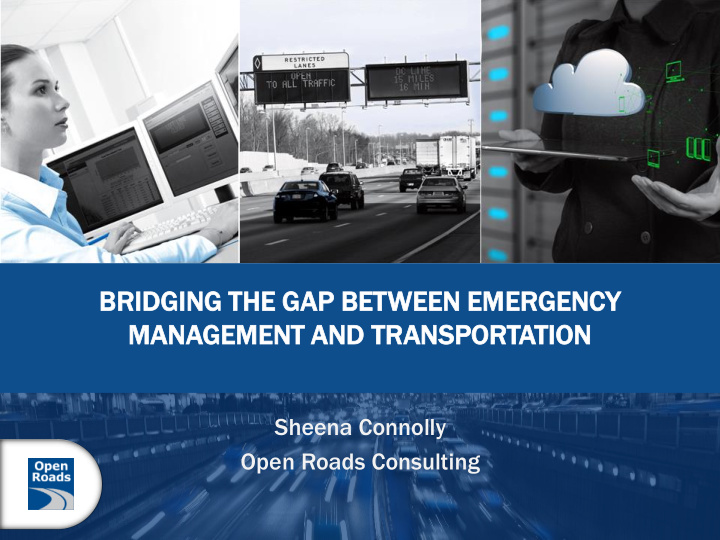



BRIDGI DGING NG THE GAP P BETWEEN WEEN EMERGENC GENCY Y MANAGEMENT GEMENT AND TRANSPORT NSPORTATI TION ON Sheena Connolly Open Roads Consulting
Your Perspective on Transportation 1. What’s your perspective on transportation? (e.g. experience, use, incidents) 2. Why is an understanding of transportation important? 2
Sheena Connolly M.S. in Emergency Management & Homeland Security with a focus in Transportation Security from Mass Maritime Academy 10 Years in transportation industry Member of several industry groups User of transportation - aviation, marine, highway and transit systems 3
It’s Exciting! 4
Introduction The overall goal of transportation agencies from state to federal level is to move people and goods efficiently, safely and to keep them moving. This presentation will provide a high level understanding and importance of emergency management as it pertains to the transportation industry and transportation security. 5
Holistic Transportation Approach Our System is Multi-modal Transit Railroads Aviation Marine Pipeline Highway Intermodal 6
Importance of Transportation A Major Part of Our Economy A Major Part of Our Personal Finances Creates jobs An Enormous Infrastructure to Monitor and Protect 7
Emergency Management Compre prehe hensive Emerge rgency y Manageme gement nt (CEM) M): An inte tegra grated d approac ach to the manageme gement nt of emerge rgency ncy pro rograms grams and activities for all four ur emerge rgency ncy phases (Plann nning, ng, Mitigat gation on, , Respon onse, , and Recovery), for all types of emerge genci ncies and disasters (natur ural al, man-made made, and attack) k), , and for all levels of gove overn rnme ment nt and the privat ate sector. 8
Comprehen prehensiv ive e Emergenc rgency Man anag agement ement • A comprehensive CEM addresses all hazards through the four phases: • Mitigation (including prevention) • Preparedness • Response • Recovery • ICS is used for response and recovery phases as well as for preparedness pre- planning activities. 9
Understanding Risks Is this a risk? 10
Understanding Transportation Threats & Vulnerabilities Vandalism, fare evasion & other crimes on transit •Smuggling and cargo theft •Attacks on passenger -carrying vehicles – Aircraft - Subways – Buses - Cruise Ships – Trains - Automobiles •Attacks using transportation vehicles •Attacks on transportation terminals and infrastructure •Attacks on cargo shipments (hijacking, piracy) •Attacks using cargo and mail shipments •Attacks on transportation control and information systems and communications networks 11
Roles in Emergency Response 12
Minnesota I-35W Bridge Collapse Case Study 13
Impact of I-35W Bridge Collapse The collapse of the I-35W Bridge impacted: ― People ― Economy ― Environment ― Transportation means • Marine • Rail • Highway • Bicycle and pedestrian 140,000 cars per day to downtown Minneapolis and University of Minnesota Estimated economic losses of $17M in 2007 and $43M in 2008 14
I-35W Case Study How well did they respond? What helped their preparedness? How well did they recover and rebuild? How did technology help? Are they prepared for a security event? 15
Support From Enhanced Emergency Response System Local Police Media Local Fire Rescue MNDOT FBI evidence team US Navy Divers 16
TOC’s & Emergency Management 17
New I-35W St. Anthony Falls Bridge: Restored to a More Robust Level Embedded sensors 18
I-35W Conclusions 19
Transportation Security Management Major Points – The Challenge Our system is multi-modal and global Goal of the National Transportation System is to move people and goods efficiently, and keep them moving It’s a tough business, facing major challenges Safety is always the top priority and “security” is necessary to ensure “safety” Operators must consider other priorities, i.e. throughput, rapid restoration, customer convenience and privacy, etc. The transportation system can be a target or part of response Threats are continuously changing and now include cyber threats 20
Key Points 1. Regional security and EM strategies should be multimodal, multi-agency; planning, preparation, relationships and partnerships are critical 2. A risk-based approach will help prioritize security investments 3. An all-hazards approach can produce multiple benefits and maximize ROI 4. The openness of the system, the diversity of threats and the lack of completely effective mitigation measures require a layered approach 5. Federal grants are a key source of funding 6. Security strategies should integrate policies, procedures, training and technologies 7. Employee, customer and public awareness/vigilance are important 8. ITS and technologies that improve situational awareness can improve protection, response, recovery and resilience 9. Technologies should be implemented as part of an integrated enterprise architecture 10. Recovery and restoration after an incident are opportunities to improve to more robust levels 21
Questions 22
Contact Information Sheena C. Connolly Project Manager/Emergency Management & Homeland Security Specialist +1(603)505-1446 sheena.connolly@openroadsconsulting.com 23
Recommend
More recommend